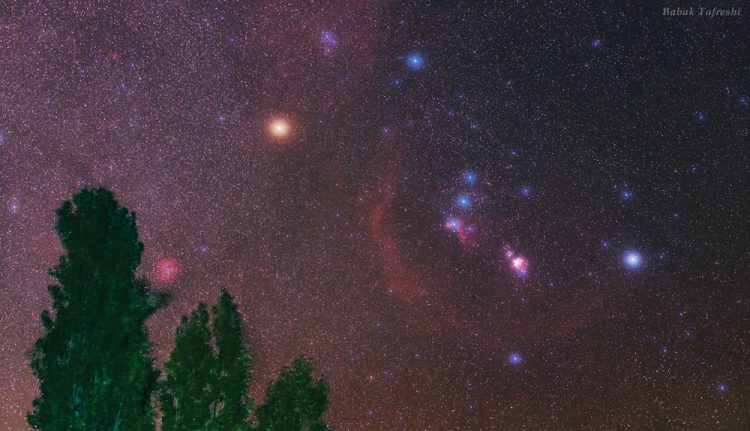If We Had Super Eyes
Description
If our eyes were more sensitive to light and if they were able to realize colors at dark we would see stunning starry views with red emitting diffuse nebulae in the sky, as shown in the above image. As noted by the photographer “This is what I call a deep sky landscape astrophoto. I’m interested in creating such views as they display where the deep sky objects are located and how large or how small they are compared to familiar objects like a tree top or the Moon. This is not a digital composite of foreground and sky. It is a panoramic image of 4 images (each 2 minutes of exposure) taken of Monoceros and Orion region. I made a flash on the foreground trees and I also placed a skyglow (deep sky) filter in front of the lens to keep the background sky dark in order to pop out the red emission nebulae.” Above the trees is an emission nebula known as the Rosette (5000 light years away) in the constellation Monoceros. On its right is the constellation Orion, the Hunter, with bright orange-red star Betelgeuse at the hunter’s shoulder and the white-blue star known as Rigel at the Orion’s left knee. Below the three aligned stars of Orion’s belt are the Horsehead dark nebula and the Great Orion Nebula, one of the most spectacular nebulae in our sky. In the middle of the image is a large red arc known as the Barnard’s Loop; an emission nebula which is part of a giant molecular cloud which also contains the Horsehead and Orion nebulae at between 1500 and 1600 light-years away. The stars within the Orion Nebula are probably responsible for ionizing the loop. The loop extends over 10 degrees or 20 times more than the Full Moon in our sky. But its actual dimensions in space is about 300 light years across which is 300,000 times larger than our Solar System planetary size (the orbit of the furthest planet).

comments (1)
WOOOOW.this is the best photo that i see from this part of sky .thanks
December 26, 2010 at 2:57 pm